
Concept explainers
Consider the graph of the function on the right.
(a) Find the domain and the range of .
(b) List the intercepts.
(c) Find .
(d) For what value of does ?
(e) Solve .
(f) Graph .
(g) Graph .
(h) Graph .
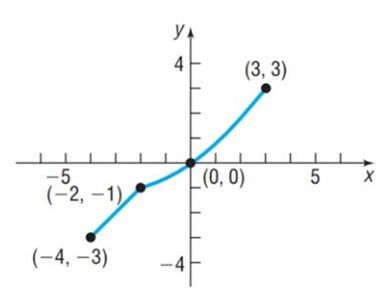
To find:
a. The domain and the range of .
Answer to Problem 16RE
Solution:
a. .
Explanation of Solution
Given:
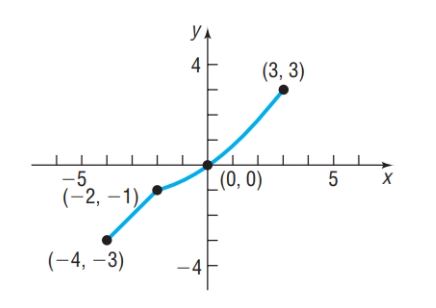
Calculation:
a. Domain: set of all the values of for which graph is defined.
.
Range: set of all the values of for which graph is defined.
.
To find:
b. List the intercepts.
Answer to Problem 16RE
Solution:
b. and are .
Explanation of Solution
Given:

Calculation:
b. and .
To find:
c.
Answer to Problem 16RE
Solution:
c.
Explanation of Solution
Given:

Calculation:
c.
To find:
d. For what value of does ?
Answer to Problem 16RE
Solution:
d.
Explanation of Solution
Given:

Calculation:
d. If , then (as per the point in the graph).
To find:
e. when .
Answer to Problem 16RE
Solution:
e.
Explanation of Solution
Given:

Calculation:
e. When , then in other words, .
To find:
f. Graph .
Answer to Problem 16RE
Solution:
f. Graph of is plotted.
Explanation of Solution
Given:

Calculation:
f. To get the graph , we shift the graph 3 units to the right.
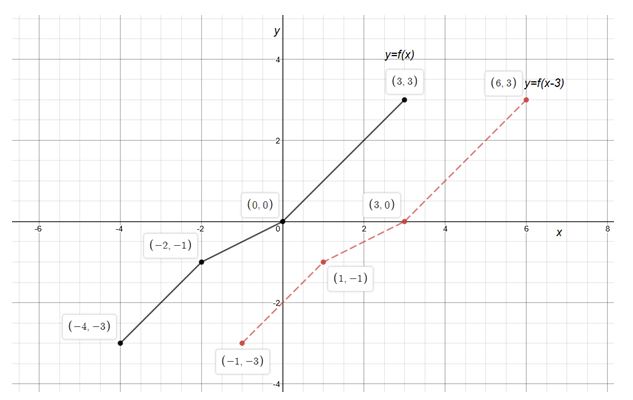
The red dotted line shows the graph of .
To find:
g. Graph .
Answer to Problem 16RE
Solution:
g. Graph of is plotted.
Explanation of Solution
Given:

Calculation:
g. To graph , we stretch the graph of by a factor of 2.
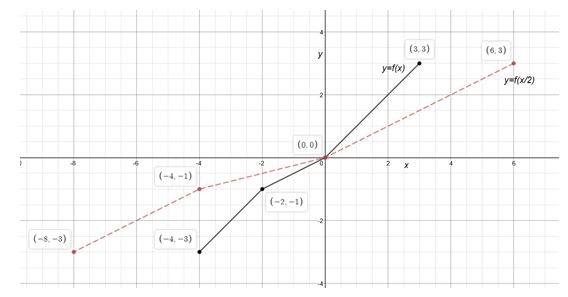
The red dotted line shows the graph of .
To find:
h. Graph .
Answer to Problem 16RE
Solution:
h. Graph of is plotted.
Explanation of Solution
Given:

Calculation:
h. To Graph , we reflect the graph of .
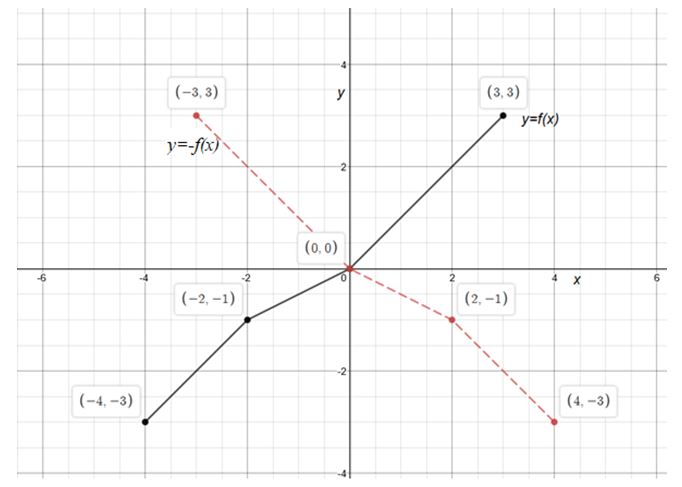
The red dotted line shows the graph of .
Chapter 2 Solutions
Precalculus Enhanced with Graphing Utilities
Additional Math Textbook Solutions
Thinking Mathematically (6th Edition)
Elementary Statistics (13th Edition)
College Algebra (7th Edition)
Introductory Statistics
Calculus for Business, Economics, Life Sciences, and Social Sciences (14th Edition)
A Problem Solving Approach To Mathematics For Elementary School Teachers (13th Edition)
- Can you help explain what I did based on partial fractions decomposition?arrow_forwardSuppose that a particle moves along a straight line with velocity v (t) = 62t, where 0 < t <3 (v(t) in meters per second, t in seconds). Find the displacement d (t) at time t and the displacement up to t = 3. d(t) ds = ["v (s) da = { The displacement up to t = 3 is d(3)- meters.arrow_forwardLet f (x) = x², a 3, and b = = 4. Answer exactly. a. Find the average value fave of f between a and b. fave b. Find a point c where f (c) = fave. Enter only one of the possible values for c. c=arrow_forward
- please do Q3arrow_forwardUse the properties of logarithms, given that In(2) = 0.6931 and In(3) = 1.0986, to approximate the logarithm. Use a calculator to confirm your approximations. (Round your answers to four decimal places.) (a) In(0.75) (b) In(24) (c) In(18) 1 (d) In ≈ 2 72arrow_forwardFind the indefinite integral. (Remember the constant of integration.) √tan(8x) tan(8x) sec²(8x) dxarrow_forward
- Find the indefinite integral by making a change of variables. (Remember the constant of integration.) √(x+4) 4)√6-x dxarrow_forwarda -> f(x) = f(x) = [x] show that whether f is continuous function or not(by using theorem) Muslim_mathsarrow_forwardUse Green's Theorem to evaluate F. dr, where F = (√+4y, 2x + √√) and C consists of the arc of the curve y = 4x - x² from (0,0) to (4,0) and the line segment from (4,0) to (0,0).arrow_forward
 Calculus: Early TranscendentalsCalculusISBN:9781285741550Author:James StewartPublisher:Cengage Learning
Calculus: Early TranscendentalsCalculusISBN:9781285741550Author:James StewartPublisher:Cengage Learning Thomas' Calculus (14th Edition)CalculusISBN:9780134438986Author:Joel R. Hass, Christopher E. Heil, Maurice D. WeirPublisher:PEARSON
Thomas' Calculus (14th Edition)CalculusISBN:9780134438986Author:Joel R. Hass, Christopher E. Heil, Maurice D. WeirPublisher:PEARSON Calculus: Early Transcendentals (3rd Edition)CalculusISBN:9780134763644Author:William L. Briggs, Lyle Cochran, Bernard Gillett, Eric SchulzPublisher:PEARSON
Calculus: Early Transcendentals (3rd Edition)CalculusISBN:9780134763644Author:William L. Briggs, Lyle Cochran, Bernard Gillett, Eric SchulzPublisher:PEARSON Calculus: Early TranscendentalsCalculusISBN:9781319050740Author:Jon Rogawski, Colin Adams, Robert FranzosaPublisher:W. H. Freeman
Calculus: Early TranscendentalsCalculusISBN:9781319050740Author:Jon Rogawski, Colin Adams, Robert FranzosaPublisher:W. H. Freeman
 Calculus: Early Transcendental FunctionsCalculusISBN:9781337552516Author:Ron Larson, Bruce H. EdwardsPublisher:Cengage Learning
Calculus: Early Transcendental FunctionsCalculusISBN:9781337552516Author:Ron Larson, Bruce H. EdwardsPublisher:Cengage Learning





